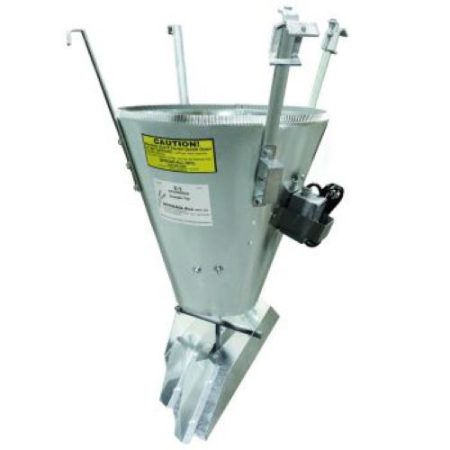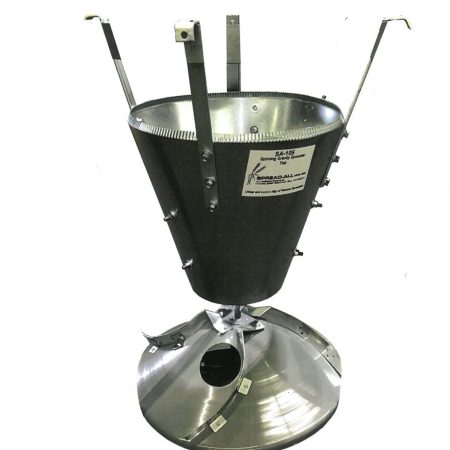The Importance of Grain Bin Spreaders in Effective Grain Storage
In modern grain storage operations, efficiency, safety, and grain quality are essential for maximizing profitability and minimizing losses. While grain bins themselves are fundamental structures, the equipment used within them plays a critical role in ensuring stored grain remains in optimal condition. One such piece of equipment, often overlooked but vitally important, is the grain bin spreader. Designed to evenly distribute grain as it enters the bin, grain spreaders help prevent common storage issues such as grain segregation, spoilage, and poor airflow. By promoting uniform distribution, grain spreaders improve aeration, enhance grain quality, and support a safer, more efficient storage process.
Understanding Grain Bin Spreaders
A grain bin spreader is a mechanical device installed at the top of a grain bin. Its primary function is to evenly distribute incoming grain throughout the bin during the filling process. As grain is augered or conveyed into the bin, the spreader rotates or oscillates, spreading the grain in a controlled pattern across the bin floor instead of allowing it to form a central cone.
Without a spreader, grain naturally piles into a peak, causing fine material (fines) to concentrate in the center of the bin. This uneven distribution of material not only affects grain quality but also leads to several critical storage issues.
The Problems with Uneven Grain Distribution
When grain is allowed to pile unevenly without the use of a spreader, a series of issues can arise:
-
Center Concentration of Fines: Fines are smaller, broken pieces of grain or debris that tend to migrate to the center during the filling process. These fines restrict airflow, creating a dense core in the bin that traps moisture and heat.
-
Poor Airflow and Aeration: Proper aeration relies on uniform airflow through the grain mass. When grain is unevenly distributed, airflow becomes obstructed in denser areas, leading to moisture buildup and poor conditioning.
-
Increased Risk of Spoilage: Uneven grain distribution leads to temperature differentials and moisture pockets. These “hot spots” can become breeding grounds for mold, insects, and bacteria, accelerating spoilage and reducing the overall value of the grain.
-
Structural Stress on the Bin: Uneven loading puts unnecessary stress on bin walls and floors. Over time, this can cause warping or even structural failure, especially in larger commercial bins.
How Grain Spreaders Solve These Problems
Grain spreaders address all of the above issues by ensuring that grain is deposited evenly across the entire surface of the bin floor. By preventing the buildup of fines in the center, spreaders promote uniform airflow, which is essential for efficient aeration and cooling. When the grain mass is level and evenly packed, air from bin fans can move consistently from the bottom to the top, removing excess heat and moisture and maintaining grain quality.
Some advanced grain spreaders even incorporate fines-separating technology, directing fines to the outer edges of the bin where airflow is strongest. This separation further enhances conditioning and reduces the likelihood of spoilage.
Benefits of Using Grain Bin Spreaders
1. Improved Grain Quality
By promoting consistent airflow and temperature control, grain spreaders help preserve the physical and nutritional quality of stored grain. Uniform conditioning reduces the chances of grain clumping, mold growth, and insect infestation.
2. Enhanced Aeration Efficiency
Spreaders allow aeration systems to perform at their best by creating an even grain profile. This means less energy is wasted, and fans don’t need to work as hard to maintain optimal conditions inside the bin.
3. Reduced Labor and Maintenance
Bins filled with uneven grain often require additional labor during unloading. Workers may need to enter the bin to level grain manually or clear clumps, posing serious safety risks. With a spreader in place, grain unloading is smoother, safer, and less labor-intensive.
4. Extended Storage Time
Because grain is stored in a healthier condition, it can remain in the bin for longer periods without quality loss. This gives producers greater flexibility in marketing and selling their crops when market conditions are most favorable.
5. Protection of Infrastructure
Even loading reduces stress on the structural components of a grain bin. Spreaders help protect your investment by reducing the chances of mechanical damage, structural fatigue, or bin failure.
Types of Grain Spreaders
Grain spreaders come in a variety of designs, suited for different bin sizes, grain types, and operational needs. The two most common types include:
-
Gravity Grain Spreaders: These are simple, passive devices that rely on gravity and the natural flow of grain to distribute it evenly. They are cost-effective and require no power but may be less precise in high-capacity systems.
-
Powered Grain Spreaders: Equipped with motors and rotating arms, powered spreaders offer more control and can handle larger volumes of grain. They are ideal for commercial-scale operations and bins that store thousands of bushels.
Choosing the right spreader depends on your bin size, grain type, and handling volume. Many manufacturers offer adjustable or customizable options to meet a wide range of farm and commercial needs.
Conclusion
In the world of grain storage, small decisions can have a major impact. While often overlooked, the grain bin spreader is one of the most important tools for ensuring safe, efficient, and profitable storage. By promoting even grain distribution, supporting effective aeration, and reducing the risk of spoilage, spreaders play a crucial role in maintaining grain quality and protecting your investment.
Whether you’re managing a single on-farm bin or a large commercial grain system, installing a grain spreader is a smart move that delivers both immediate and long-term benefits. When it comes to storing grain right, it all starts with a level foundation—and that begins with a reliable grain bin spreader


